EMD "GP38," "GP38-2," and "GP38AC": Data Sheet, Specs, Roster
Last revised: December 17, 2024
By: Adam Burns
The GP38 was a four-axle, mid-powered road-switcher produced by Electro-Motive from January, 1966 to December, 1971. It was one of several new models the builder released in 1965 sporting the new 645 prime mover.
Designed for general freight service, over 700 units were produced by the time production had switched to the upgraded Dash 2 line in 1972. There were only very minor differences between the GP38/GP38AC while the GP38-2's changes were almost entirely internal.
As Gerald Foster notes in his book, "A Field Guide To Trains," EMD masterfully read the market in the mid-1960s for a moderately powered road-switcher. The entire GP38 series' production run - which included the GP38, GP38AC, and GP38-2 and spanned two decades (1966-1986) - saw some 3,180 units produced.
As a result of the GP38's success, hundreds remain in widespread use throughout the country, particularly on regionals and shortlines. To date, there is only one currently-known GP38 officially preserved; Tennessee, Alabama & Georgia #80 at the Tennessee Valley Railroad Museum.
Photos
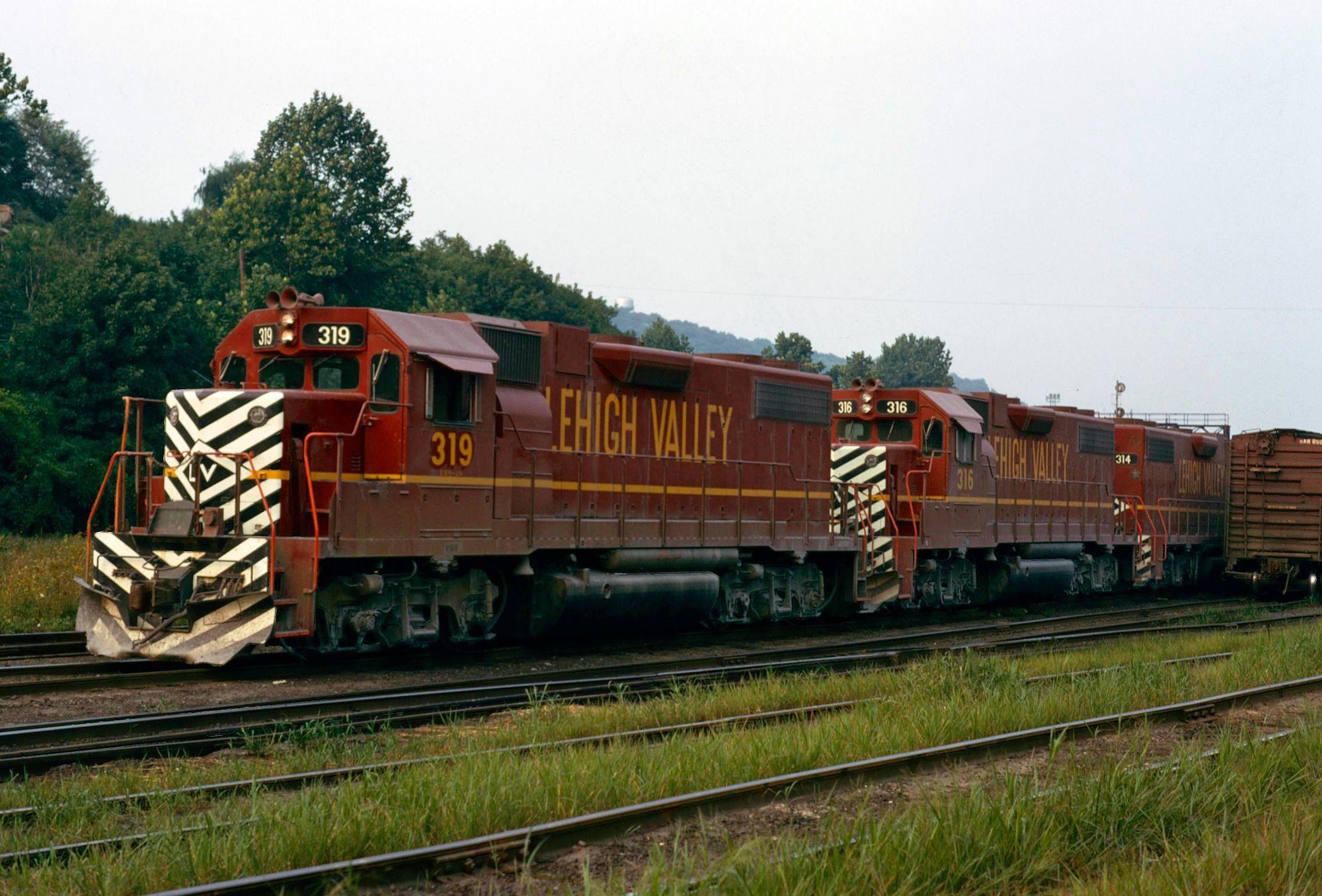 Lehigh Valley GP38-2's #319, #316, and #314 at work in the summer of 1973. American-Rails.com collection.
Lehigh Valley GP38-2's #319, #316, and #314 at work in the summer of 1973. American-Rails.com collection.Overview
In his book, "EMD Locomotives," author Brian Solomon notes that in late 1965 the builder advertised nine new models equipped with its latest model 645 engine offered in a range of horsepower ratings, sizes, and wheel arrangements.
Not every railroad at that time needed - or could handle - the big SD38s, SD40s, and SD45s. As a result, there remained a strong demand for smaller, modestly powered models capable of handling a variety of assignments.
The GP38 fit this role perfectly. It directly superseded the GP35, the final four-axle variant to carry the legendary 567 engine. Aside from an upgraded prime mover and a carbody three feet longer than its predecessor, the GP38 was, externally, very similar.
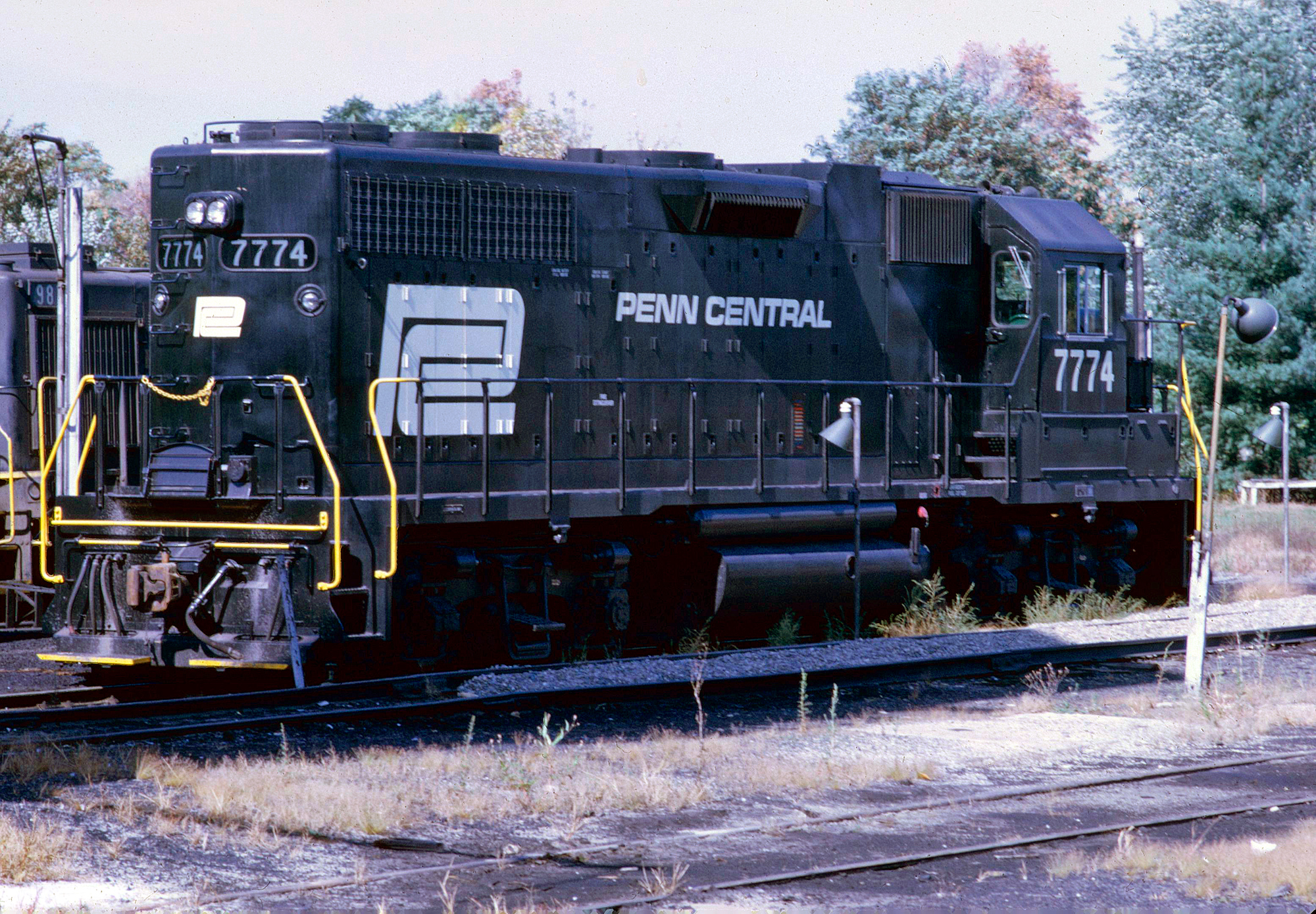 At an undisclosed location not listed on the slide, a recently delivered Penn Central GP38 lays over between assignments in early October of 1969. American-Rails.com collection.
At an undisclosed location not listed on the slide, a recently delivered Penn Central GP38 lays over between assignments in early October of 1969. American-Rails.com collection.The first production GP38 was Detroit, Toledo & Ironton #200, completed in January, 1966. Its 16-cylinder, model 645E engine, aspirated with Roots blowers, could produce 2,000 horsepower.
The model initially featured a convential electrical system. However, after 1971 EMD began offering an AC/DC system to handle the optional AR10 alternator in place of the standard D32 direct-current generator.
The reasoning behind an alternator was space savings, as Louis Marre notes in his book, "Diesel Locomotives: The First 50 Years."
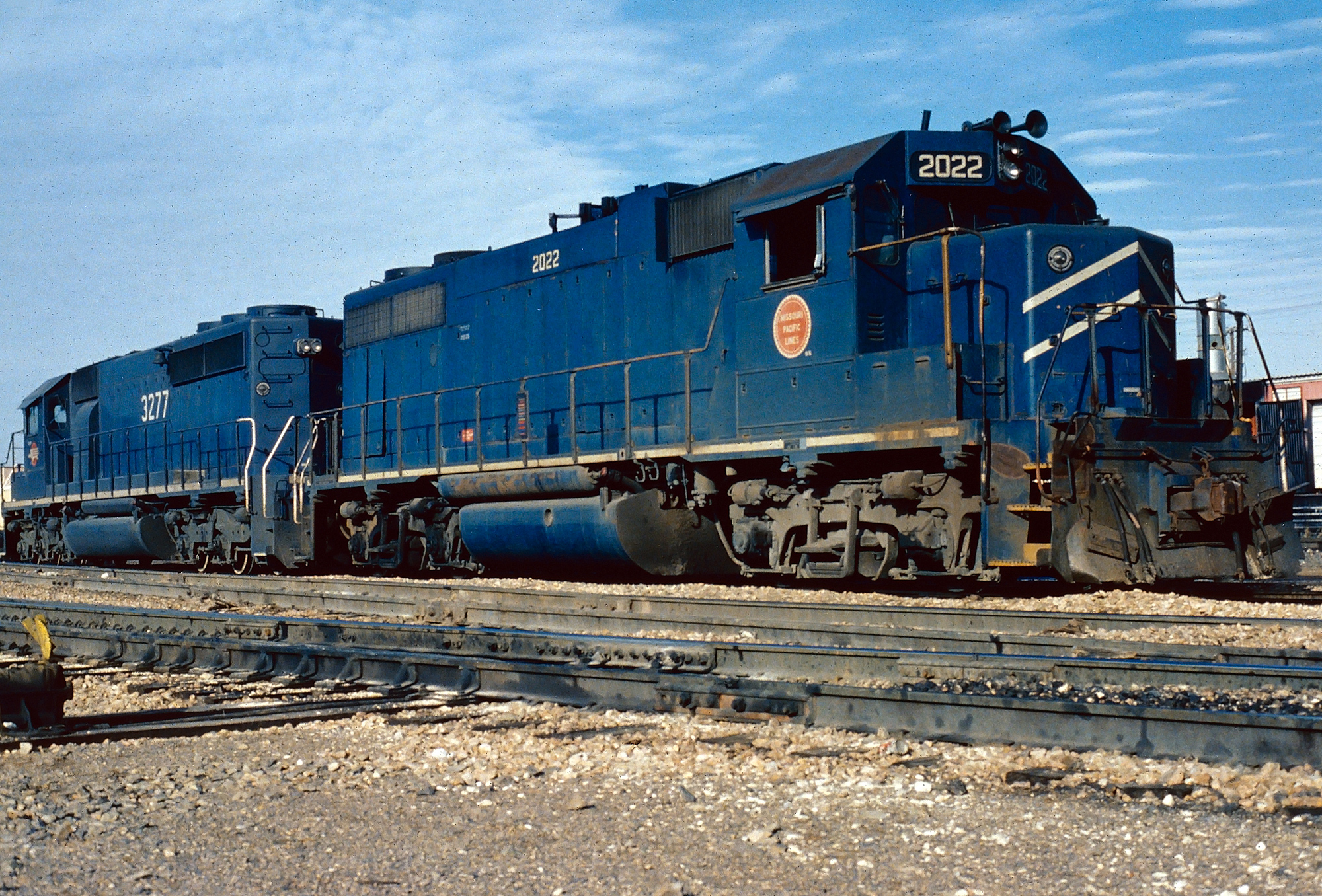 Missouri Pacific GP38-2 #2022 and SD40-2 #3277 at Taylor, Texas, circa 1982. Mike Bledsoe photo. American-Rails.com collection.
Missouri Pacific GP38-2 #2022 and SD40-2 #3277 at Taylor, Texas, circa 1982. Mike Bledsoe photo. American-Rails.com collection.As horsepower ratings increased, the size of DC generators likewise increased. With space inside an engine hood limited, the use of a more efficient alternator solved this problem. The so-called GP38AC variant, however, saw only 261 examples produced to a handful of railroads.
In 1972, EMD released its "Dash 2" line, which included the GP38-2. In his book, "Locomotives: The Modern Diesel & Electric Reference," author Greg McDonnell notes EMD listed 40 refinements to the Dash 2 line although nearly all of these were internal, aimed at improving locomotive efficiency and operation.
In doing so the GP38-2 was more reliable while also featuring increased tractive effort and reduced emissions. Railroads loved the upgraded design; it was so successful EMD kept the GP38-2 in its catalog until 1985. By the time production ended, some 2,213 units had been produced.
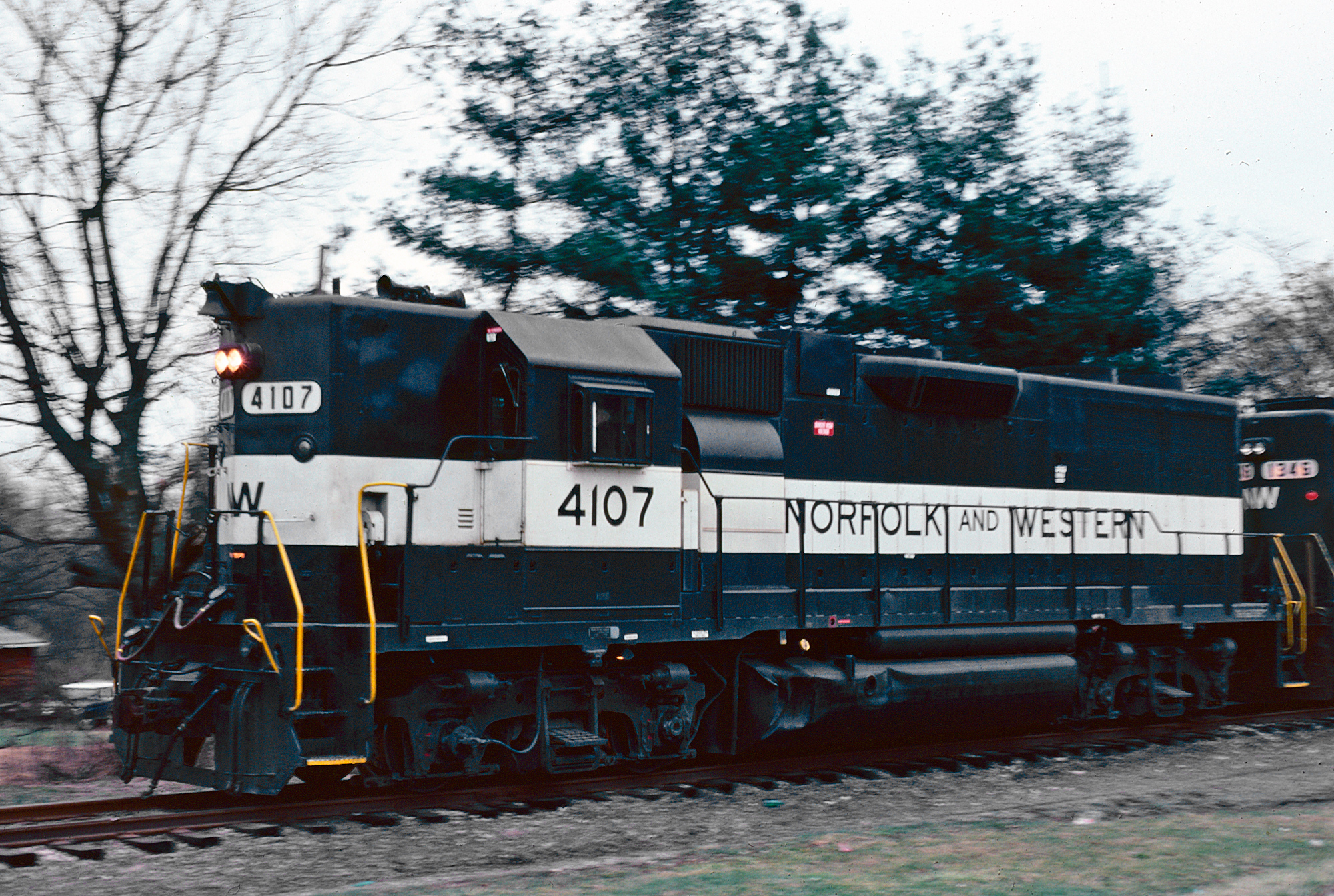 Norfolk & Western GP38AC #4107, wearing the experimental "Skunk" paint scheme bearing a large white strip around the carbody; December, 1982. Location not recorded. American-Rails.com collection.
Norfolk & Western GP38AC #4107, wearing the experimental "Skunk" paint scheme bearing a large white strip around the carbody; December, 1982. Location not recorded. American-Rails.com collection.Except for the later GP40 and GP40-2, the GP38 series was EMD’s most successful second-generation Geep and fit exactly what railroads were looking for in terms of horsepower and quality.
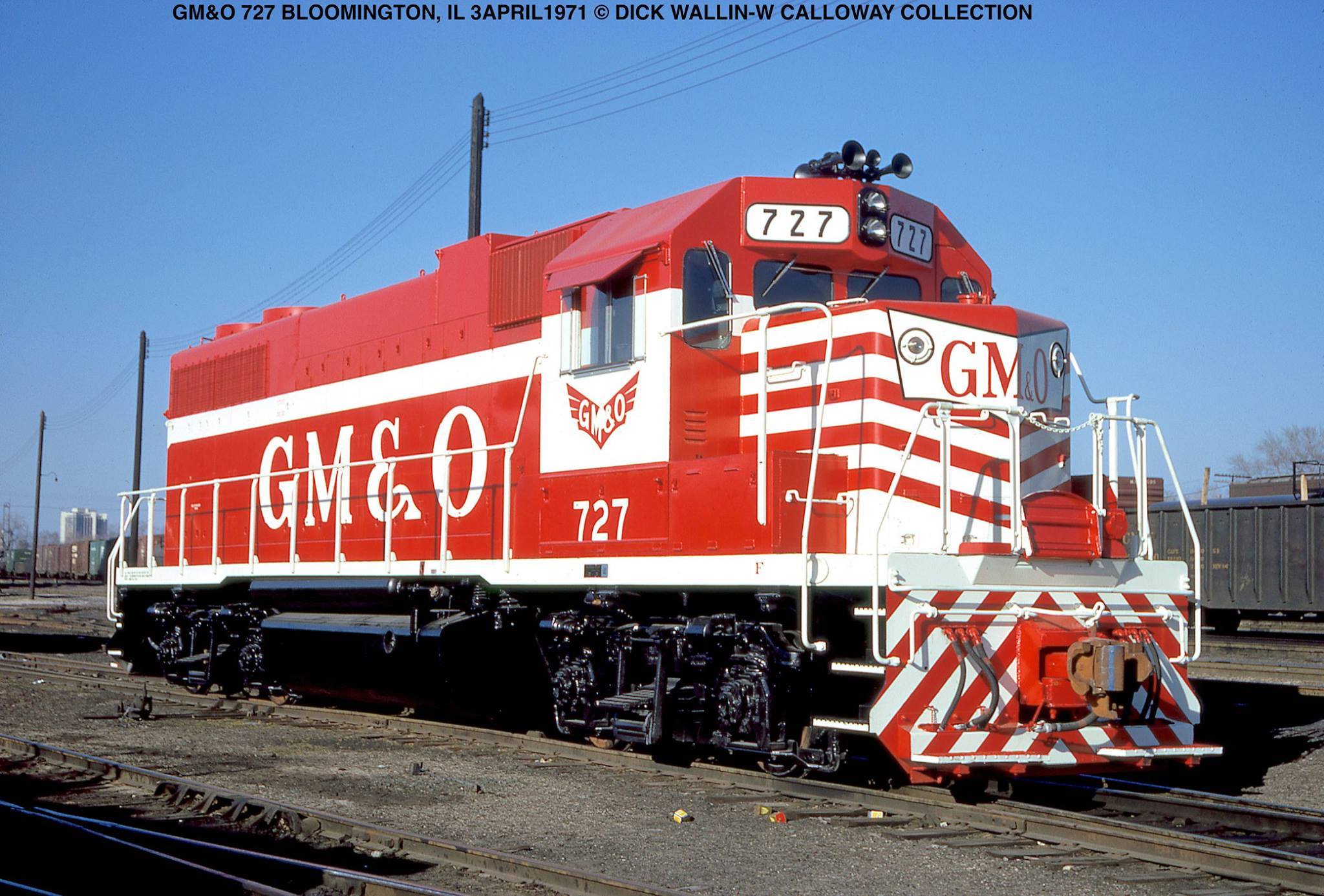 A brand new Gulf, Mobile & Ohio GP38AC, #727, at Bloomington, Illinois on April 3, 1971. Dick Wallin photo/Warren Calloway collection.
A brand new Gulf, Mobile & Ohio GP38AC, #727, at Bloomington, Illinois on April 3, 1971. Dick Wallin photo/Warren Calloway collection.Spotting Features
The GP38 series is most easily distinguishable from other models by its twin exhaust stacks for its nonturbocharged 645E prime mover. In addition, it featured only two rear radiator cooling fans, instead of the three found on the more powerful GP40 series.
However, identifying the GP38/GP38AC from the GP38-2 is a much more difficult undertaking. Perhaps the most prominent feature is a water-level sight-glass window cut into the right-side hood door.
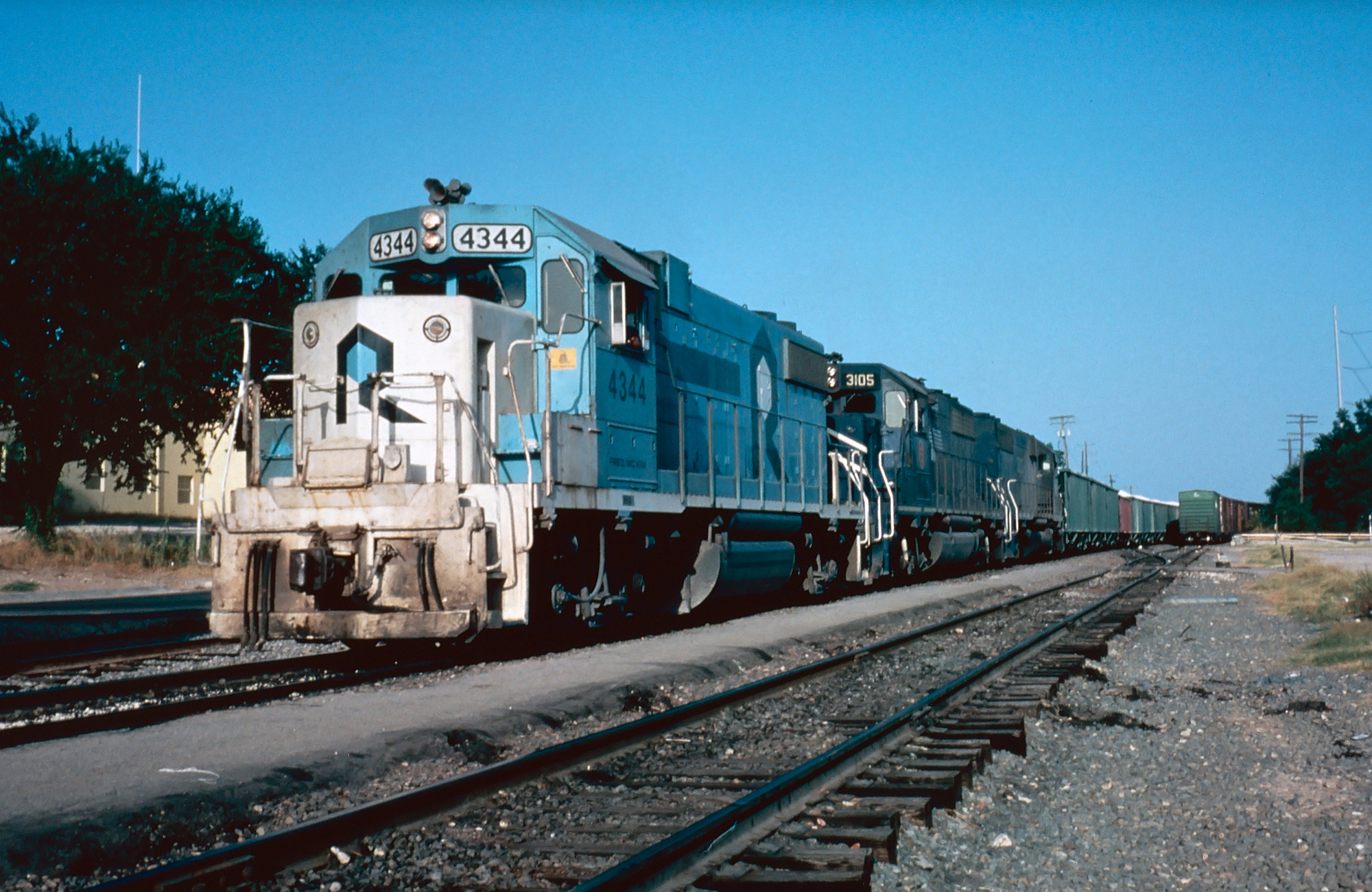 A former Rock Island GP38-2, formerly named the "Fred McKim," is ahead of this Missouri Pacific freight at Austin, Texas in May, 1980. Following the Rock's shutdown, Missouri Pacific picked up the railroad's fleet of GP38-2's. Mike Bledsoe photo. American-Rails.com collection.
A former Rock Island GP38-2, formerly named the "Fred McKim," is ahead of this Missouri Pacific freight at Austin, Texas in May, 1980. Following the Rock's shutdown, Missouri Pacific picked up the railroad's fleet of GP38-2's. Mike Bledsoe photo. American-Rails.com collection.One other notable characteristic is the use of EMD's latest truck design, the high-traction Blomberg-M. It featured damping struts and rubber-buffered springs in place of leaf springs and was offered only on the GP38-2.
Finally, the Dash 2's sported bolted-on access plates for the battery box, which replaced the earlier hinged and latched design. Burlington Northern, however, was one notable holdout for the older design, electng to have its Dash 2's equipped with the traditional setup.
Data Sheet
| Entered Production (GP38) | 1/1966 (Detroit, Toledo & Ironton #200) |
| Entered Production (GP38AC) | 5/1970 (Detroit, Toledo & Ironton #210) |
| Entered Production (GP38-2) | 1/1972 (Louisville & Nashville #4050) |
| Years Produced (GP38) | 1/1966 - 8/1971 |
| Years Produced (GP38AC) | 5/1970 - 12/1971 |
| Years Produced (GP38-2) | 1/1972 - 5/1985 |
| Engine (GP38 and GP38AC) | 645 |
| Engine (GP38-2) | 645E |
| Engine Builder | GM |
| Horsepower | 2000 |
| RPM | 800 |
| Cylinders | 16 |
| Length | 59' 2" |
| Height (Top Of Rail To Top Of Cab) | 15' 5" (GP38 and GP38AC) |
| Height (Top Of Rail To Top Of Cab) | 15' 4" (GP38-2) |
| Width (GP38 and GP38AC) | 10' 4" |
| Width (GP38-2) | 10' 4 ½" |
| Weight (GP38 and GP38AC) | 245,000 Lbs |
| Weight (GP38-2) | 250,000 Lbs |
| Fuel Capacity | 1700 Gallons |
| Air Compressor | Gardner-Denver |
| Air Compressor Model | WBO |
| Air Brake Manufacturer | Westinghouse |
| Air Brake Schedule | 24L |
| Trucks | B-B |
| Truck Type | Blomberg |
| Truck Wheelbase | 9' |
| Wheel Size | 40" |
| Traction Motors | D77 (4), GM |
| Primary Generator (GP38) | D32, GM |
| Primary Alternator (GP38AC and GP38-2) | AR10, GM |
| Auxiliary Generator | Delco (64-72) |
| Alternator | D14 |
| MU (Multiple-Unit) | Yes |
| Dynamic Brakes | Yes |
| Gear Ratio | 62:15 |
| Tractive Effort (Starting) | 61,000 Lbs at 25% |
| Tractive Effort (Continuous) | 50,000 Lbs at 10.8 mph (GP38 and GP38AC) |
| Tractive Effort (Continuous) | 54,700 Lbs at 11.1 mph (GP38-2) |
| Top Speed | 65 mph |
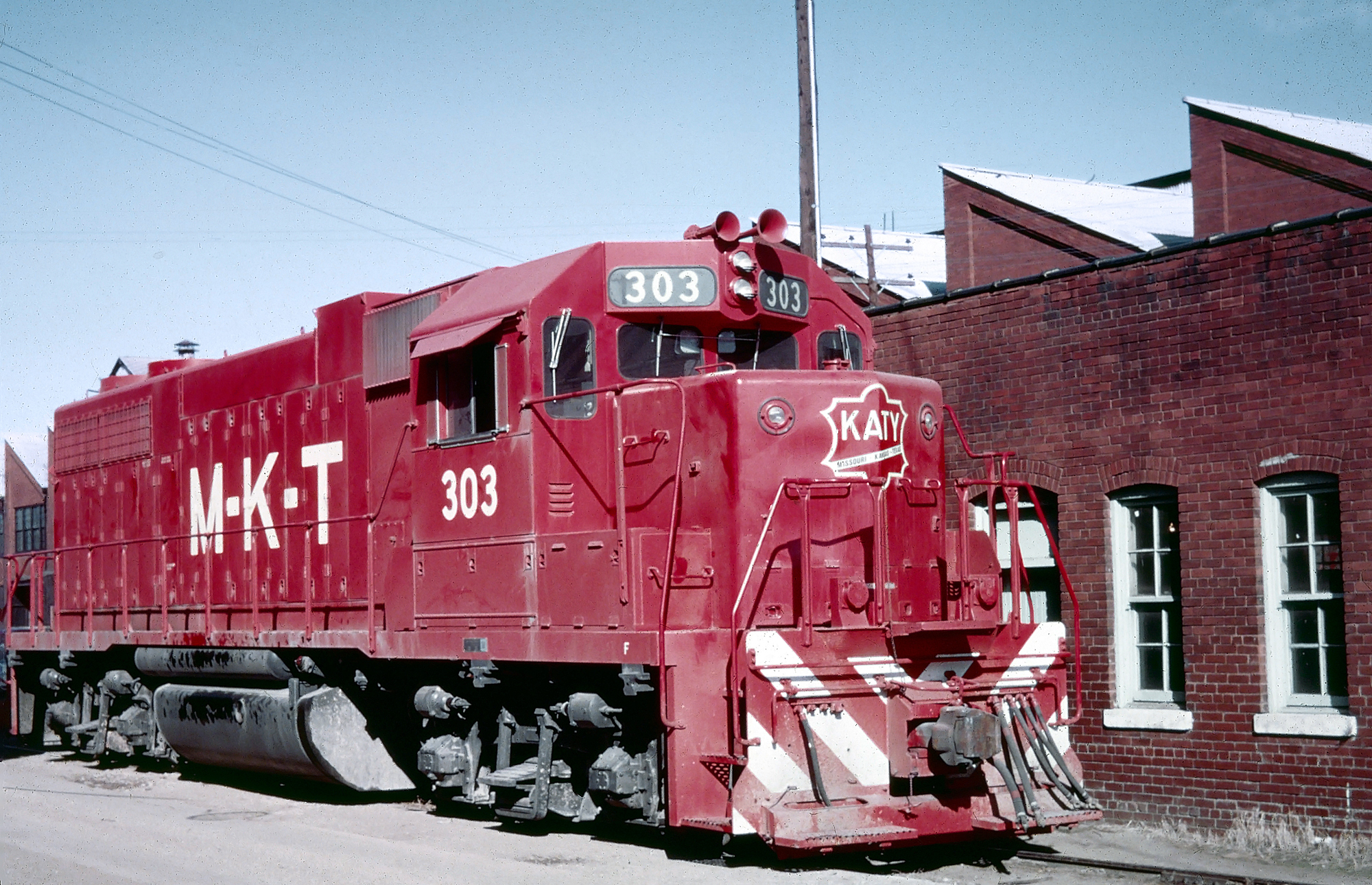 One of the Katy's few GP38's it owned, #303, is seen here at the shops in Parsons, Kansas in 1969. American-Rails.com collection.
One of the Katy's few GP38's it owned, #303, is seen here at the shops in Parsons, Kansas in 1969. American-Rails.com collection.Production Rosters
GP38
Total Built = 706
| Owner | Road Number(s) | Serial Number(s) | Order Number | Completion Date |
|---|---|---|---|---|
| Detroit, Toledo & Ironton | 200-204 | 31064-31068 | 7844 | 1/1966-2/1966 |
| Bangor & Aroostook | 81-82 | 31213-31214 | 7858 | 2/1966-3/1966 |
| Norfolk Southern | 2001-2002 | 31782-31783 | 7895 | 6/1966 |
| Erie Mining Company | 700-701 | 31949-31950 | 5706 | 1/1967 |
| Phelps Dodge Corporation (Morenci Mine) | 47-48 | 32290-32291 | 5721 | 10/1966 |
| Norfolk Southern | 2003-2004 | 32308-32309 | 7925 | 10/1966 |
| Texas-Mexican | 857 | 32461 | 5719 | 11/1966 |
| Norfolk Southern | 2005-2007 | 32491-32493 | 7937 | 6/1967-7/1967 |
| Missouri Pacific | 572-574 | 32495-32497 | 7938 | 10/1966 |
| Missouri Pacific | 575 | 32608 | 7938 | 10/1966 |
| Maine Central | 251-262 | 32660-32671 | 7946 | 11/1966-12/1966 |
| Missouri Pacific | 576 | 32672 | 7938 | 11/1966 |
| Texas-Mexican | 858 | 32673 | 7947 | 6/1967 |
| Bangor & Aroostook | 83-84 | 33050-33051 | 7980 | 3/1967 |
| Bangor & Aroostook | 85 | 33052 | 5726 | 3/1967 |
| Clinchfield | 2000-2009 | 33062-33071 | 5724 | 4/1967 |
| Phelps Dodge Corporation (Morenci Mine) | 49-52 | 33072-33075 | 5725 | 4/1967 |
| Missouri Pacific | 577 | 33174 | 7999 | 6/1967 |
| Bangor & Aroostook | 86 | 33199 | 5734 | 11/1967 |
| Bangor & Aroostook | 87-88 | 33200-33201 | 7059 | 11/1967 |
| Maine Central | 263 | 33280 | 7065 | 10/1967 |
| Baltimore & Ohio | 3800-3849 | 33318-33367 | 7060 | 10/1967-11/1967 |
| Chesapeake & Ohio | 3850-3899 | 33681-33730 | 7060 | 11/1967-12/1967 |
| Pennsylvania-Reading Seashore Lines | 2000-2004 | 33797-33801 | 7076 | 12/1967 |
| Tennessee, Alabama & Georgia | 80 | 33802 | 5736 | 2/1968 |
| Aberdeen & Rockfish | 400 | 34029 | 5737 | 6/1968 |
| Pennsylvania-Reading Seashore Lines | 2005-2009 | 34752-34756 | 7154 | 4/1969 |
| Monongahela Railway | 2000-2004 | 35074-35078 | 7182 | 8/1969 |
| Gulf, Mobile & Ohio | 701-720 | 35164-35183 | 7185 | 8/1969 |
| Southern | 2716-2727 | 35246-35257 | 7189 | 9/1969-10/1969 |
| Southern | 2728-2752 | 35258-35282 | 5744 | 9/1969-10/1969 |
| Detroit, Toledo & Ironton | 205-206 | 35291-35292 | 7188 | 9/1969 |
| Penn Central | 7675-7814 | 35304-35443 | 7191 | 6/1969-11/1969 |
| Penn Central | 7815-7824 | 35444-35453 | 7202 | 11/1969 |
| Missouri-Kansas-Texas (Katy) | 300-303 | 35934-35937 | 7230 | 12/1969 |
| Burlington Northern | 2072-2076 | 35995-35999 | 5754 | 2/1970 |
| Burlington Northern | 2077 | 36000 | 7239 | 2/1970 |
| Southern | 2753-2777 | 36001-36025 | 7240 | 10/1969-11/1969 |
| Southern | 2778-2822 | 36026-36070 | 7240 | 1/1970-3/1970 |
| Louisville & Nashville | 4000-4019 | 36313-36332 | 7257 | 6/1970-7/1970 |
| Penn Central | 7825-7867 | 36441-36483 | 7265 | 5/1970-6/1970 |
| Santa Fe | 3500-3560 | 36536-36586 | 7266 | 6/1970-9/1970 |
| Chesapeake & Ohio | 4820-4829 | 36666-36675 | 7274 | 7/1970-8/1970 |
| Baltimore & Ohio | 4800-4819 | 36676-36695 | 7274 | 8/1970-12/1970 |
| Pennsylvania-Reading Seashore Lines | 2010-2014 | 36801-36805 | 7281 | 11/1970 |
| Penn Central | 7868-7903, 7908-7937 | 36927-36992 | 7291 | 1/1971-3/1971 |
| Penn Central | 7904-7907 | 36993-36996 | 7299 | 3/1971-4/1971 |
| Penn Central | 7938-7939 | 37011-37012 | 7291 | 3/1971-4/1971 |
| Phelps Dodge Corporation (Morenci Mine) | 53-54 | 37375-37376 | 5769 | 4/1971 |
| Texas-Mexican | 859 | 37424 | 5770 | 8/1971 |
| Texas-Mexican | 860 | 7373-1 | 7373 | 8/1971 |
Reused Serials
| Owner | Road Number(s) | Serial Number(s) | Order Number | Completion Date |
|---|---|---|---|---|
| Baltimore & Ohio | 3837 | 33355 | 8085 | 7/1971 |
Export
| Owner | Road Numbers | Serial Numbers | Order Numbers | Completion Date |
|---|---|---|---|---|
| Altos Hornos de México-AHMSA | 130-131 | 33184-33185 | 710935-710936 | 7/1967 |
| Altos Hornos de México-AHMSA | 135-136 | 37266-37267 | 711869-711870 | 6/1971 |
| Southeastern United Railways (Mexico) | 512-513 | 37617-37618 | 711970-711971 | 9/1971 |
GP38AC
Total Built = 261
| Owner | Road Number(s) | Serial Number(s) | Order Number | Completion Date |
|---|---|---|---|---|
| Norfolk & Western | 4100-4124 | 35620-35644 | 7326 | 8/1971, 10/1971 |
| Norfolk & Western | 4125-4139 | 35645-35659 | 5775 | 6/1971 |
| Norfolk & Western | 4140-4144 | 35660-35664 | 5775 | 9/1971-10/1971 |
| Illinois Central | 9500-9519 | 35665-35684 | 5747 | 2/1970 |
| Louisville & Nashville | 4020-4029 | 35973-35982 | 7234 | 5/1971 |
| Gulf, Mobile & Ohio | 721-727 | 36079-36085 | 5766 | 3/1971-4/1971 |
| Gulf, Mobile & Ohio | 730-732 | 36086-36088 | 7304 | 4/1971 |
| Detroit, Toledo & Ironton | 210-217 (215-217 renumbered 209, 208, 207 upon delivery) | 36333-36340 | 7258 | 5/1970 |
| Detroit, Toledo & Ironton | 215-220 | 36866-36871 | 7287 | 7/1971 |
| St. Louis-San Francisco Railway (Frisco) | 633-648 | 37018-37033 | 7293 | 2/1971 |
| Louisville & Nashville | 4030-4039 | 37268-37277 | 7305 | 5/1971 |
| Southern | 2823-2836 | 37295-37308 | 7307 | 4/1971-5/1971 |
| Southern | 2837-2850 | 37309-37322 | 7307 | 9/1971-11/1971 |
| Southern | 2851-2878 | 37323-37350 | 5778 | 8/1971-10/1971 |
| St. Louis-San Francisco Railway (Frisco) | 654-658 | 37437-37441 | 7313 | 4/1971 |
| St. Louis-San Francisco Railway (Frisco) | 649-653 | 37442-37446 | 7293 | 2/1971-3/1971 |
| St. Louis-San Francisco Railway (Frisco) | 659-662 | 37447-37450 | 7313 | 2/1971-4/1971 |
| Gulf, Mobile & Ohio | 728-729 | 37451-37452 | 5766 | 4/1971 |
| Louisville & Nashville | 4040-4049 | 37629-37638 | 7305 | 5/1971-6/1971 |
| Pacific Power & Light Company | 11 | 37891 | 5785 | 12/1971 |
| Grand Trunk Western | 5800-5811 | 37929-37940 | 7333 | 12/1971 |
| Norfolk & Western | 4145-4159 | 38188-38202 | 5775 | 9/1971-12/1971 |
| Lehigh Valley | 310-313 | 7368-1 thru 7368-4 | 7368 | 12/1971 |
| Gulf, Mobile & Ohio | 733 | 7388-1 | 7388 | 12/1971 |
GP38-2
Total Built = 2,213
| Owner | Road Number(s) | Serial Number(s) | Completion Date |
|---|---|---|---|
| Louisville & Nashville | 4050-4059 | 5806-1 thru 5806-10 | 1/1972 |
| Belt Railway of Chicago | 490-495 | 5807-1 thru 5807-6 | 8/1972-9/1972 |
| Southern | 5000-5009 | 5809-1 thru 5809-10 | 1/1972-2/1972 |
| St. Louis-San Francisco Railway (Frisco) | 678-682 | 5810-1 thru 5810-5 | 3/1972 |
| Louisville & Nashville | 4060-4069 | 7339-1 thru 7339-10 | 4/1972 |
| St. Louis-San Francisco Railway (Frisco) | 663-677 | 7342-1 thru 7342-15 | 3/1972 |
| Missouri Pacific | 858-902 | 7344-1 thru 7344-45 | 1/1972-2/1972 |
| Gulf, Mobile & Ohio | 740-754 | 7351-1 thru 7351-15 | 4/1972, 8/1972 |
| Penn Central | 7940-8039 | 7354-1 thru 7354-100 | 5/1972-8/1972 |
| Southern | 5010-5054 | 7362-1 thru 7362-45 | 2/1972-3/1972 |
| Burlington Northern | 2078-2087 | 7369-1 thru 7369-10 | 5/1972 |
| Lehigh Valley | 314-325 | 7386-1 thru 7386-12 | 11/1972 |
| Missouri Pacific | 923-959 | 71702-1 thru 71702-37 | 1/1973-5/1973 |
| Louisville & Nashville | 4090-4099 | 72604-1 thru 72604-10 | 10/1972 |
| Louisville & Nashville | 4070-4089 | 72704-1 thru 72704-20 | 9/1972 |
| Elgin, Joliet & Eastern | 700-703 | 72614-1 thru 72614-4 | 12/1972 |
| Penn Central | 8040-8153 | 72627-1 thru 72627-114 | 2/1973-3/1973 |
| St. Louis-San Francisco Railway (Frisco) | 683-691 | 72634-1 thru 72634-9 | 12/1972 |
| St. Louis-San Francisco Railway (Frisco) | 692-699 | 72734-1 thru 72734-8 | 11/1972-12/1972 |
| Louisville & Nashville | 4115-4124 | 72635-1 thru 72635-10 | 3/1973 |
| Louisville & Nashville | 4100-4114 | 72735-1 thru 72735-15 | 2/1973-3/1973 |
| Missouri-Kansas-Texas (Katy) | 304-313 | 72644-1 thru 72644-10 | 12/1972 |
| Southern | 5059-5103 | 72745-1 thru 72745-45 | 8/1973-10/1973 |
| Southern | 5055-5058 | 72653-1 thru 72653-4 | 12/1972 |
| Public Service Company of Indiana | WG1-WG2 | 72656-1, 72656-2 | 4/1974 |
| Missouri Pacific | 913-922 | 72659-1 thru 72659-10 | 10/1972 |
| Missouri Pacific | 903-912 | 72759-1 thru 72759-10 | 9/1972-10/1972 |
| Vermont Railway | 201 | 72665-1 | 1/1972 |
| Durham & Southern | 2000-2003 | 72670-1 thru 72670-4 | 12/1972 |
| Seaboard Coast Line | 500-524 | 72785-1 thru 72785-25 | 3/1973-4/1973 |
| Atlanta & St Andrews Bay | 508-509 | 72686-1, 72686-2 | 5/1973 |
| Milwaukee Road | 350-355 | 72689-1 thru 72689-6 | 6/1973 |
| Kansas City Southern | 4000-4009 | 72691-1 thru 72691-10 | 1/1974 |
| St. Louis-San Francisco Railway (Frisco) | 400-417 | 73606-1 thru 73606-18 | 6/1973-7/1973 |
| St. Louis-San Francisco Railway (Frisco) | 418-425 | 73706-1 thru 73706-8 | 7/1973 |
| Seaboard Coast Line | 525-555 | 73607-1 thru 73607-31 | 10/1973-11/1973 |
| Penn Central | 8154-8162 | 73608-1 thru 73608-9 | 10/1973 |
| Elgin, Joliet & Eastern | 704 | 73618-1 | 10/1973 |
| Louisville & Nashville | 4125-4144 | 73631-1 thru 73631-20 | 8/1973-9/1973 |
| Colorado & Wyoming | 2001-2002 | 73632-1, 73632-2 | 11/1973-12/1973 |
| Boston & Maine | 201-212 | 73636-1 thru 73636-12 | 12/1973 |
| Phelps Dodge Corporation | 1-3 | 73640-1 thru 73640-3 | 10/1973 |
| Southern | 5104-5107 | 73652-1 thru 73652-4 | 1/1974 |
| Southern | 5108-5138 | 73752-1 thru 73752-31 | 1/1974-2/1974 |
| Union Pacific | 2000-2039 | 73662-1 thru 73662-40 | 3/1974-6/1974 |
| Southern | 5139-5162 | 73677-1 thru 73677-24 | 10/1974 |
| Missouri Pacific | 2111-2120 | 73679-1 thru 73679-10 | 9/1974-10/1974 |
| Milwaukee Road | 356-365 | 74610-1 thru 74610-10 | 9/1974 |
| St. Louis-San Francisco Railway (Frisco) | 426-446 | 74617-1 thru 74617-21 | 8/1974 |
| Texas-Mexican | 861-862 | 74625-1, 74625-2 | 9/1974 |
| Missouri-Kansas-Texas (Katy) | 314-317 | 74629-1 thru 74629-4 | 8/1974 |
| San Manuel Arizona | 16-17 | 74631-1, 74631-2 | 10/1974-11/1974 |
| Illinois Central Gulf | 9600-9639 | 74646-1 thru 74646-40 | 11/1974-12/1974 |
| Detroit, Toledo & Ironton | 221-228 | 74652-1 thru 74652-8 | 8/1975 |
| Burlington Northern | 2088-2109 | 74674-1 thru 74674-22 | 11/1974 |
| Union Pacific | 2040-2059 | 74675-1 thru 74675-20 | 4/1975 |
| Missouri Pacific | 2121-2132 | 74689-1 thru 74689-12 | 1/1975-2/1975 |
| St. Louis-San Francisco Railway (Frisco) | 447-458 | 74693-1 thru 74693-12 | 1/1975 |
| Vermont Railway | 202 | 75603-1 | 10/1974 |
| Southern | 5163-5171 | 75614-1 thru 75614-9 | 8/1975 |
| Atlanta & St Andrews Bay | 510 | 75623-1 | 7/1975 |
| Mississippi Export | 65 | 75645-1 | 9/1975 |
| Armco Steel | B84 | 756065-1 | 9/1975 |
| Long Island Rail Road | 250-271 | 756091-1/22 | 1/1976-2/1976 |
| Cleveland Electric Illuminating Company | 100-108 | 756112-1 thru 756112-9 | 10/1975 |
| Phelps Dodge Corporation (Morenci Mine) | 9, 55-56 | 756116-1 thru 756116-3 | 3/1976 |
| Rock Island | 4300-4314 | 756136-1 thru 756136-15 | 8/1976-9/1976 |
| Rock Island | 4315-4355 | 757136-1 thru 757136-41 | 9/1976-11/1876 |
| Missouri-Kansas-Texas (Katy) | 318-321 | 767003-1 thru 767003-4 | 6/1976 |
| Missouri Pacific | 2133-2137 | 766004-1 thru 766004-5 | 7/1976-8/1976 |
| Butte, Anaconda & Pacific | 108 | 766008-1 | 2/1977 |
| Southern | 5172-5201 | 767011-1 thru 767011-30 | 9/1976-10/1986 |
| Southern | 5202-5225 | 767017-1 thru 767017-24 | 1/1977 |
| St. Louis-San Francisco Railway (Frisco) | 459-478 | 767030-1 thru 767030-20 | 11/1976-12/1976 |
| Phelps Dodge Corporation | 4 | 766036-1 | 3/1977 |
| Long Island Rail Road | 272-277 | 766041-1 thru 766041-6 | 3/1977-4/1977 |
| Southern | 5226-5231 | 767053-1 thru 767053-6 | 2/1977 |
| Toledo, Peoria & Western | 2001-2004 | 766058-1 thru 766058-4 | 5/1977 |
| Illinois Terminal | 2001-2004 | 766065-1 thru 766065-4 | 6/1977 |
| Pittsburgh & Lake Erie | 2051-2056 | 766073-1 thru 766073-6 | 6/1977 |
| Conrail | 8163-8180 | 767077-1 thru 767077-18 | 6/1977 |
| Soo Line | 790-796 | 777020-1 thru 777020-7 | 9/1977-10/1977 |
| Missouri Pacific | 2138-2147 | 776034-1 thru 776034-10 | 10/1977 |
| Missouri Pacific | 2148-2157 | 777035-1 thru 777035-10 | 10/1977-11/1977 |
| Florida East Coast | 501-504 | 776040-1 thru 776040-4 | 11/1977-12/1977 |
| Florida East Coast | 511 | 777041-1 | 4/1978 |
| Texas-Mexican | 863 | 776077-1 | 6/1978 |
| Grand Trunk Western | 5812-5831 | 776095-1 thru 776095-20 | 12/1978 |
| Florida East Coast | 505-510 | 776110-1 thru 776110-6 | 4/1978 |
| Soo Line | 797-799 | 777112-1 thru 777112-3 | 4/1978-5/1978 |
| Toledo, Peoria & Western | 2005-2011 | 776122-1 thru 776122-7 | 10/1978 |
| Conrail | 8181-8201 | 777125-1 thru 777125-21 | 5/1978-6/1978 |
| Conrail | 8202-8223 | 777126-1/22 | 7/1978-8/1978 |
| Clinchfield (Family Lines) | 6000-6004 | 777132-1 thru 777132-5 | 6/1978 |
| Kansas City Southern | 4010-4011 | 786135-1/2 | 6/1978 |
| Butte, Anaconda & Pacific | 109 | 786138-1 | 12/1978 |
| Conrail | 8224-8255 | 787147-1 thru 787147-32 | 9/1978 |
| Rock Island | 4368-4379 | 786157-1 thru 786157-12 | 11/1978-12/1978 |
| Soo Line | 4410-4415 | 786161-1/6 | 10/1978 |
| Soo Line | 4416-4425 | 786188-1 thru 786188-10 | 5/1979-6/1979 |
| Soo Line | 4426-4435 | 787189-1 thru 787189-10 | 7/1979 |
| Conrail | 8256-8281 | 787192-1 thru 787192-26 | 5/1979-6/1979 |
| Louisville & Nashville (Family Lines) | 6011-6030 | 786204-1 thru 786204-20 | 3/1979-4/1979 |
| Clinchfield (Family Lines) | 6005-6006 | 786205-1, 786205-2 | 4/1979 |
| Atlanta & West Point (Family Lines) | 6007-6008 | 786206-1, 786206-2 | 4/1979 |
| Georgia Railroad (Family Lines) | 6009-6010 | 786206-3, 786206-4 | 4/1979 |
| Mississippi Export | 66 | 786213-1 | 4/1979 |
| Texas-Mexican | 864 | 786233-1 | 9/1979 |
| South East Coal Company | 3821-3823 | 786237-1, 786237-3 | 3/1979 |
| Louisville & Nashville (Family Lines) | 6031-6044 | 786238-1 thru 786238-14 | 7/1979-8/1979 |
| Soo Line | 4436-4443 | 787255-1 thru 787255-8 | 6/1980 |
| Missouri Pacific | 2158-2197 | 787270-1 thru 787270-40 | 1/1980-2/1980 |
| Chicago & North Western | 4600-4625 | 786271-1 thru 786271-26 | 11/1979-12/1979 |
| Southern Pacific | 4800-4844 | 78272-1 thru 78272-45 | 5/1980-7/1980 |
| Southern | 5232-5256 | 786292-1 thru 786292-25 | 8/1979-9/1979 |
| Grand Trunk Western | 5832-5836 | 796298-1 thru 796298-5 | 1/1980 |
| Burlington Northern (Fort Worth & Denver) | 2150-2154 | 796299-1 thru 796299-5 | 6/1980 |
| Providence & Worcester | 2006 | 796301-1 | 2/1980 |
| Chicago & North Western | 4626-4634 | 797303-1 thru 797303-9 | 12/1979 |
| Clinchfield (Family Lines) | 6045 | 796312-1 | 8/1979 |
| Seaboard Coast Line (Family Lines) | 6046-6050 | 796313-1 thru 796313-5 | 8/1979-9/1979 |
| Missouri Pacific | 2198-2237 | 796323-1 thru 796323-40 | 7/1980-8/1980 |
| Texas-Mexican | 865 | 796326-1 | 7/1980 |
| Chicago, South Shore & South Bend | 2000-2009 | 796333-1 thru 796333-10 | 1/1981 |
| Seaboard Coast Line (Family Lines) | 6051-6054 | 797351-1 thru 797351-4 | 3/1980 |
| Providence & Worcester | 2007-2008 | 796356-1, 796356-2 | 12/1980 |
| Seaboard Coast Line (Family Lines) | 6055-6059 | 796381-1 thru 796381-5 | 10/1980-11/1980 |
| Angelina & Neches River | 2000 | 796383-1 | 8/1980 |
| Curtis, Milburn & Eastern | 817-819, 810 | 796388-1 thru 796388-4 | 1/1981 |
| Soo Line | 4444-4450 | 797394-1/7 02/81 | 2/1981 |
| Texas-Mexican | 866 | 806017-1 | 12/1980 |
| Seaboard Coast Line (Family Lines) | 6060-6065 | 807032-1 thru 807032-6 | 11/1980 |
| Missouri Pacific | 2290-2319 | 807047-1 thru 807047-30 | 2/1981-3/1981 |
| Missouri Pacific | 2320-2334 | 807052-1 thru 807052-15 | 7/1981-8/1981 |
| Phelps Dodge Corporation (Morenci Mine) | 58 | 816026-1 | 4/1982 |
| Providence & Worcester | 2009 | 827002-1 | 9/1982 |
| Soo Line | 4451-4452 | 827032-1, 827032-2 | 3/1983 |
| Texas-Mexican | 867 | 847025-1 | 5/1985 |
Export
| Owner | Road Number(s) | Serial Number(s) | Completion Date |
|---|---|---|---|
| Southeastern United Railways (Mexico) | 514-516 | 712423-712425 | 8/1972 |
| Saudi Government Railway | 2000 | 712783 | 9/1973 |
| Altos Hornos de México-AHMSA | 141 | 712953 | 1/1974 |
| Southeastern United Railways (Mexico) | 517-521 | 75630-1 thru 75630-5 | 7/1975 |
| Ferrocarril Nacional de México | 9200-9219 | 75633-1 thru 75633-20 | 6/1975 |
| Ferrocarril Nacional de México | 9401-9404 | 756056-1 thru 756056-4 | 10/1975 |
| Altos Hornos de México-AHMSA | 145 | 756062-1 | 1/1976 |
| Ferrocarril Nacional de México | 9220-9299 | 756076-1 thru 756076-80 | 10/1975-12/1975 |
| Ferrocarril Nacional de México | 9400 | 756076-81 | 12/1975 |
| Ferrocarril Chihuahua al Pacífico | 900-909 | 788017-1 thru 788017-10 | 2/1979-3/1979 |
| Ferrocarril Chihuahua al Pacífico | 910-911 | 788028-1, 788028-2 | 4/1980 |
| Ferrocarril Nacional de México | 9405-9414 | 788030-1 thru 788030-10 | 3/1979 |
| Altos Hornos de México-AHMSA | 157-158 | 788062-1, 788062-2 | 11/1978 |
| Altos Hornos de México-AHMSA | 167-168 | 798075-1, 798075-2 | 10/1980-11/1980 |
| Southeastern United Railways (Mexico) | 528-530 | 808051-1 thru 808051-3 | 8/1981 |
| Southeastern United Railways (Mexico) | 531-533 | 818024-1 thru 818024-3 | 3/1982 |
| Ferrocarril Nacional de México | 9901-9909 | 818041-1 thru 818041-9 | 6/1983-7/1983 |
General Motors Diesel Division (GMDD)
| Owner | Road Number(s) | Serial Number(s) | Order Number | Completion Date |
|---|---|---|---|---|
| Canadian National | 5500-5535 | A2673-A2708 | C350 | 11/1972-1/1973 |
| Canadian National | 5536-5559 | A2819-A2842 | C350 | 1/1973-6/1973 |
| Ontario Northland | 1800-1803 | A3109-A3112 | C373 | 11/1974 |
| Texas Gulf Sulphur Company | 054-055 | A3493-A3494 | C401 | 10/1976 |
| Devco | 216-219 | A3684-A3687 | C415 | 5/1979-6/1979 |
| Devco | 220-223 | A4063-A4066 | C432 | 4/1981 |
| Algoma Central | 200-205 | A4067-A4072 | C437 | 4/1981 |
| Devco | 224-227 | A4278-A4281 | C440 | 6/1982 |
| Ontario Northland | 1804-1807 | A4284-A4287 | C443 | 12/1982 |
| Canadian Pacific | 3021-3040 | A4318-A4337 | C445 | 4/1983-6/1983 |
| Devco | 228 | A4347 | C447 | 7/1983 |
| Ontario Northland | 1808-1809 | A4427-A4428 | C453 | 9/1984 |
| Canadian Pacific | 3041-3085 | A4502-A4546 | C456 | 10/1985-2/1986 |
| Canadian Pacific | 3086-3135 | A4637-A4686 | C462 | 3/1986-7/1986 |
| Canadian National | 5560 (GP38-2W) | A2843 | C350 | 6/1973 |
| Canadian National | 5561-5610 (GP38-2W) | A2888-A2937 | C360 | 10/1973-1/1974 |
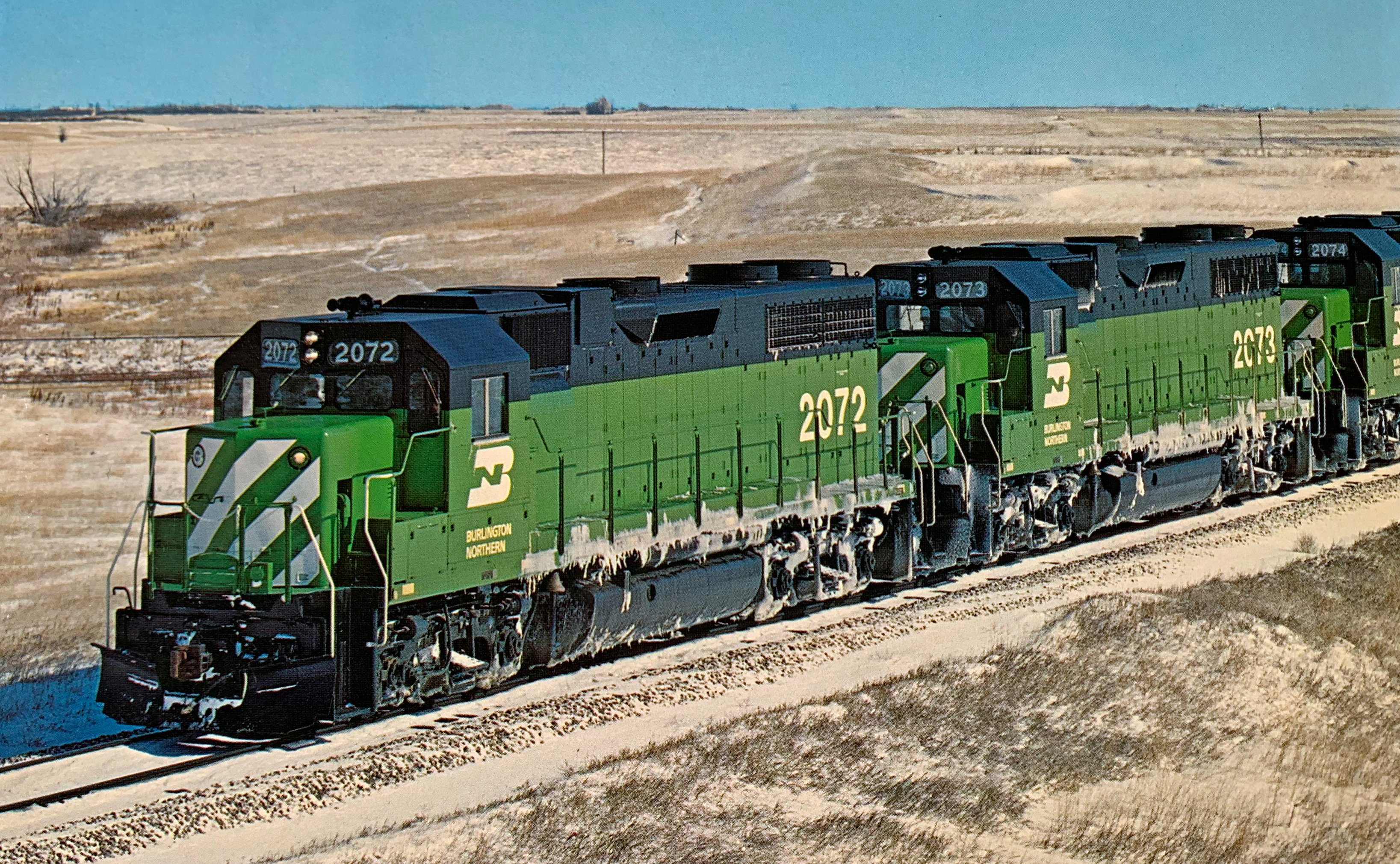 A set of six, new Burlington Northern GP38's were photographed here with time freight #97 (formerly Great Northern's "West Coaster") near Minot, North Dakota on March 3, 1970. Harr, Hedrich-Blessing photo. Author's collection.
A set of six, new Burlington Northern GP38's were photographed here with time freight #97 (formerly Great Northern's "West Coaster") near Minot, North Dakota on March 3, 1970. Harr, Hedrich-Blessing photo. Author's collection.B&O GP38 #3802
In 1982 Trains Magazine selected Baltimore & Ohio GP38 #3802 as its All American Diesel for the locomotive's performance, service, reliability and the fact that it was an extremely successful design found all across the country. The unit ended its career on CSX as #9699.
The unit has since been retired from the roster and donated to the B&O Railroad Museum for preservation. Today it awaits restoration back into its original Chessie System colors (when it received its All American status) as well as the nameplates it originally received.
Recent Articles
-
New York Dinner Train Rides In The Adirondacks!
Jan 05, 26 09:45 PM
Operating over a restored segment of the former New York Central’s Adirondack Division, the Adirondack Railroad has steadily rebuilt both track and public interest in passenger rail across the region. -
Ohio Dinner Train Rides On The CVSR!
Jan 05, 26 08:32 PM
While the railroad is well known for daytime sightseeing and seasonal events, one of its most memorable offerings is its evening dining program—an experience that blends vintage passenger-car ambience… -
Pennsylvania's - Wine Tasting - Train Rides
Jan 05, 26 01:08 PM
Wine tasting trains are a unique and enchanting way to explore the state’s burgeoning wine scene while enjoying a leisurely ride through picturesque landscapes. -
West Virginia - Wine Tasting - Train Rides
Jan 05, 26 01:02 PM
West Virginia, often celebrated for its breathtaking landscapes and rich history, offers visitors a unique way to explore its rolling hills and picturesque vineyards: wine tasting trains. -
Virginia - Wine Tasting - Train Rides
Jan 05, 26 12:58 PM
Wine tasting trains in Virginia provide just that—a unique experience that marries the romance of rail travel with the sensory delights of wine exploration. -
Utah - Wine Tasting - Train Rides
Jan 05, 26 12:37 PM
Utah, a state widely celebrated for its breathtaking natural beauty and dramatic landscapes, is also gaining recognition for an unexpected yet delightful experience: wine tasting trains. -
Kentucky Valentine's Train Rides
Jan 05, 26 12:31 PM
If you’re looking for a date night that feels a little more cinematic than the usual reservation-and-a-movie routine, Bardstown’s My Old Kentucky Dinner Train delivers the kind of evening you remember… -
Pennsylvania Valentine's Train Rides
Jan 05, 26 12:12 PM
Tucked amid the rolling farmland of Lancaster County, Pennsylvania, the Strasburg Rail Road stands as one of the most celebrated and successful heritage railroads in North America. -
New York's - Murder Mystery - Dinner Train Rides
Jan 05, 26 11:01 AM
New York State, renowned for its vibrant cities and verdant countryside, offers a plethora of activities for locals and tourists alike, including murder mystery train rides! -
Pennsylvania's - Murder Mystery - Dinner Train Rides
Jan 05, 26 10:37 AM
Pennsylvania, steeped in history and industrial heritage, offers a prime setting for a unique blend of dining and drama: the murder mystery dinner train ride. -
Missouri Dinner Train Rides In Branson!
Jan 05, 26 10:00 AM
Nestled in the heart of the Ozarks, the Branson Scenic Railway offers one of the most distinctive rail experiences in the Midwest—pairing classic passenger railroading with sweeping mountain scenery a… -
Indiana Dinner Train Rides In Jasper
Jan 05, 26 09:58 AM
In the rolling hills of southern Indiana, the Spirit of Jasper offers one of those rare attractions that feels equal parts throwback and treat-yourself night out: a classic excursion train paired with… -
Ferrocarriles Nacionales de México (N de M)
Jan 05, 26 09:57 AM
For much of the twentieth century, Ferrocarriles Nacionales de México—better known by its classic initials N de M, and later as FNM/Ferronales—served the heart of Mexico. -
Texas's - Murder Mystery - Dinner Train Rides
Jan 04, 26 10:57 AM
Here’s a comprehensive look into the world of murder mystery dinner trains in Texas. -
Connecticut's - Murder Mystery - Dinner Train Rides
Jan 04, 26 10:54 AM
All aboard the intrigue express! One location in Connecticut typically offers a unique and thrilling experience for both locals and visitors alike, murder mystery trains. -
New Hampshire's - Murder Mystery - Dinner Train Rides
Jan 04, 26 10:42 AM
The state's murder mystery trains stand out as a captivating blend of theatrical drama, exquisite dining, and scenic rail travel. -
Michigan - Whiskey - Train Rides
Jan 03, 26 02:10 PM
There's a unique thrill in combining the romance of train travel with the rich, warming flavors of expertly crafted whiskeys. -
Indiana's - Murder Mystery - Dinner Train Rides
Jan 03, 26 08:58 AM
This piece explores the allure of murder mystery trains and why they are becoming a must-try experience for enthusiasts and casual travelers alike. -
Ohio's - Murder Mystery - Dinner Train Rides
Jan 03, 26 08:54 AM
The murder mystery dinner train rides in Ohio provide an immersive experience that combines fine dining, an engaging narrative, and the beauty of Ohio's landscapes. -
Vermont - Wine Tasting - Train Rides
Jan 02, 26 08:06 PM
Known for its stunning green mountains, charming small towns, and burgeoning wine industry, Vermont offers a unique experience that seamlessly blends all these elements: wine tasting train rides.
Sources
- Foster, Gerald. A Field Guide To Trains. New York: Houghton Mifflin, 1996.
- Marre, Louis A. and Pinkepank, Jerry A. Contemporary Diesel Spotter's Guide, The: A Comprehensive Reference Manual To Locomotives Since 1972. Milwaukee: Kalmbach Publishing Company, 1989.
- McDonnell, Greg. Locomotives: The Modern Diesel & Electric Reference, 2nd Edition. Buffalo: Boston Mills Press/Firefly Books, 2015.
- Solomon, Brian. EMD Locomotives. Minneapolis: MBI Publishing Company, 2006.
- Solomon, Brian. GE and EMD Locomotives: The Illustrated History. Minneapolis: Voyageur Press, 2014.




















